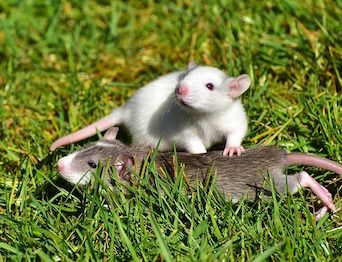Pain Assessment with the Rat Grimace Scale
The rat grimace scale is a reliable way to determine pain levels in rats following surgical experimental procedures.

In a recent study, a team of Romanian researchers reported preliminary results demonstrating that the rat grimace scale (RGS) can assess pain levels in rats reliably following surgical experimental procedures.
The 3 R’s of animal research—replace, reduce, refine—were developed over 50 years ago to ensure humane laboratory animal care. Pain control, wrote the current study’s researchers, is “one of the most important refinement strategies” in laboratory animal research. Unfortunately, only about 20% of laboratory rats undergoing surgical experimental procedures receive postoperative analgesia.
Effective pain control in laboratory animals relies on accurate quantification of pain. Traditional pain assessment methods evaluate physiologic and behavioral changes, which may not adequately reflect pain intensity.
The face grimace scale, originally developed to assess pain in nonspeaking humans, was recently validated for pain assessment in several laboratory animals, including rats.
The RGS rates pain from 0 (no pain) to 2 (severe pain) based on changes in 4 facial expression categories:
- Orbital tightening
- Cheek/nose flattening
- Ear changes (position, orientation, shape)
- Whisker changes (position, orientation)
Study Design
Researchers assessed pain in 5 healthy female laboratory rats. Four rats were ovariectomized (OVX) under general anesthesia and assigned to 1 of 4 treatment groups (1 rat/treatment group):
- OVX without analgesia
- OVX + preoperative tramadol 25 mg/kg
- OVX + postoperative tramadol 25 mg/kg
- OVX + postoperative tramadol 50 mg/kg
One rat served as control and did not undergo surgery or receive tramadol. Tramadol was selected because it is commonly used to relieve postoperative pain in animals. In this study, tramadol was administered subcutaneously.
Pain was assessed at 0, 2, 4, and 6 hours after surgery by recording the rats in glass cages for 10 minutes at each time point.
Results
Overall, pain was most severe (1.5—2) for OVX without analgesia. Preoperative 25 mg/kg tramadol provided only short-term analgesia, with moderate to severe pain (1–1.5) beginning 2 hours after OVX. Postoperative tramadol dosed at 25 mg/kg resulted in moderate pain (0.5–1.25). Postoperative tramadol at 50 mg/kg resulted in the least severe pain (0.25).
For each facial expression category, researchers observed variable pain levels in the treatment groups across time points:
- Orbital tightening: Throughout the study period, pain was severe (eyes tightly closed) for OVX without analgesia. For OVX with analgesia, the pain was moderate at most time points, with postsurgical analgesia resulting in no observable pain at 6 hours after surgery.
- Nose/cheek flattening: Pain was severe (nose elongated and cheeks absent) immediately after surgery for OVX without analgesia and 25 mg/kg tramadol (pre- and postoperative). Starting 2 hours after surgery, pain was moderate for each treatment group.
- Ear position: Pain was severe (ears curled and angled outward) for most treatment groups immediately after surgery. Starting 2 hours after surgery, the pain tapered to a moderate level for each treatment group.
- Whisker position: OVX without analgesia led to pain that was severe (whiskers angled outward and bunched together) immediately after surgery and moderate thereafter. OVX with analgesia resulted in moderate pain throughout the study period.
Discussion
These preliminary results indicate the reliability of the RGS in assessing postoperative pain in laboratory rats. In particular, the scores suggest that, in ovariectomized rats, 25 mg/kg tramadol provides inadequate analgesia and 50 mg/kg tramadol provides optimal analgesia.
Because of the study’s small sample size, further research will be needed to determine the dose and administration of tramadol needed to achieve optimal analgesia in laboratory rats undergoing surgical procedures.
Dr. JoAnna Pendergrass received her Doctor of Veterinary Medicine degree from the Virginia-Maryland College of Veterinary Medicine. Following veterinary school, she completed a postdoctoral fellowship at Emory University’s Yerkes National Primate Research Center. Dr. Pendergrass is the founder and owner of JPen Communications, a medical communications company.